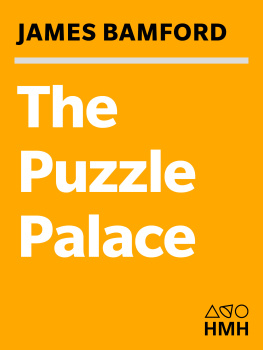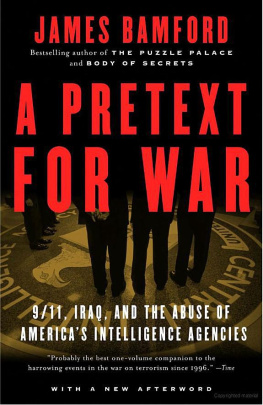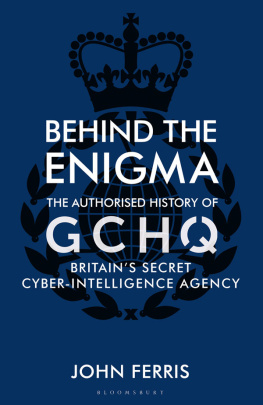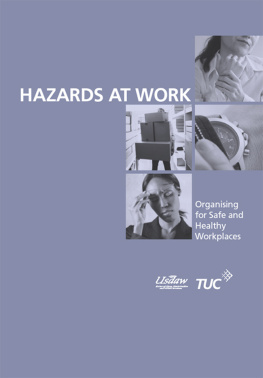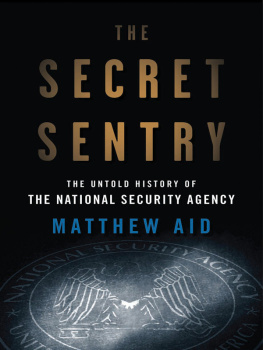Copyright 1982 by V. James Bamford
For information about permission to reproduce selections from this book, write to or to Permissions, Houghton Mifflin Harcourt Publishing Company, 3 Park Avenue, 19th Floor, New York, New York 10016.
hmhco.com
Library of Congress Cataloging in Publication Data
Bamford, James.
The puzzle palace.
Includes bibliographical references and index.
1. United States. National Security Agency. I. Title.
UB251.U5B35 327.1'2'06073 82-3056
ISBN 0-395-31286-8 AACR2
e ISBN 978-1-328-56689-8
v1.0518
For Nancy
who endured my puzzle
and sacrificed her palace
Any sound that Winston made, above the level of a very low whisper, would be picked up by it... There was of course no way of knowing whether you were being watched at any given moment... You had to livedid live, from habit that became instinctin the assumption that every sound you made was overheard and, except in darkness, every movement scrutinized.
George Orwell, 1984
Secrecy is the first essential in affairs of the State.
Armandjean du Plessis, Cardinal de Richelieu, chief minister to King Louis XIII
The King has note of all that they intend, By interception which they dream not of.
William Shakespeare, The Life of Henry V, Act II, Scene 2
Acknowledgments
I AM DEEPLY GRATEFUL to the many people who gave unselfishly of their time, knowledge, and ideas in order to help me with this book. General Marshall S. Carter, Frank Raven, Dr. Solomon Kullback, Frank Rowlett, Edna Yardley, Raymond Tate, Wesley Reynolds, Richard Floyd, Dr. William O. Baker, Clark Clifford, General Preston Corderman, and others who will remain unnamed but not unthanked, all patiently endured my endless questions and offered me their kind hospitality and a piece of the puzzle.
Others helped me arrange the pieces in their proper place. David Kahn was the source of a wealth of helpful advice and kindly took the time to review a final draft of the manuscript. John E. Taylor of the National Archives constantly found time in his busy schedule to help me locate the most obscure government documents. Linda Melvern of Londons Sunday Times provided me with continued support and assistance. Mark Lynch of the American Civil Liberties Union brought his considerable legal talents to my aid in a tug of war with the government over several documents. Tony Crawford and John Jacob of the George C. Marshall Research Library frequently went out of their way to assist me. And Claire Lorenz of the Margaret Clapp Library at Wellesley College, where I did much of my research, was never without a kind word and friendly smile as she pointed me to the right stack of Senate hearings or House reports. My appreciation also to Charles Sullivan, Gerald Everett, and the rest of NSAs D4 staff, who suffered through my torrent of Freedom of Information Act requests with professionalism and good humor.
Finally, I want to thank my editor, Robie Macauley, for the personal attention he has consistently shown to me and this project; Senior Vice President Richard McAdoo for his continued encouragement and patience over the years; my copy editor, Frances L. Apt, for her eagle eye in decrypting my manuscript; and all the other fine people at Houghton Mifflin who contributed to The Puzzle Palace.
1
Birth
A T 12:01 on the morning of November 4, 1952, a new federal agency was born. Unlike other such bureaucratic births, however, this one arrived in silence. No news coverage, no congressional debate, no press announcement, not even the whisper of a rumor. Nor could any mention of the new organization be found in the Government Organization Manual or the Federal Register or the Congressional Record. Equally invisible were the new agencys director, its numerous buildings, and its ten thousand employees.
Eleven days earlier, on October 24, President Harry S. Truman scratched his signature on the bottom of a seven-page presidential memorandum addressed to Secretary of State Dean G. Acheson and Secretary of Defense Robert A. Lovett. Classified top secret and stamped with a code word that was itself classified, the order directed the establishment of an agency to be known as the National Security Agency. It was the birth certificate for Americas newest and most secret agency, so secret in fact that only a handful in the government would be permitted to know of its existence. Even the date set for its birth was most likely designed for maximum secrecy: should any hint of its creation leak out, it would surely be swallowed up in the other news of the daythe presidential election of 1952.
Thirty years later Mr. Trumans memorandum is still one of Washingtons most closely guarded secrets. Those seven pages remain the foundation upon which all past and current communications intelligence activities of the United States government are based, according to a senior official of the National Security Council. And in its defense against a 1976 lawsuit seeking access to the memorandum, the NSA argued successfully against the release of even one word: This Memorandum remains the principal charter of the National Security Agency and is the basis of a number of other classified documents governing the conduct of communications intelligence activities and operations, functions [and] activities of the National Security Agency. Even a congressional committee was forced to issue a subpoena in order to obtain a copy of the directive that implemented the memorandum.
Three decades after its birth the agency itself remains nearly as secretive and mysterious as when it emerged from the presidential womb. Its name is no longer classified information, but virtually all other details concerning the agency continue to be.
Newsman Daniel Schorr, in his book Clearing the Air, referred to the NSA as one of the deepest secrets; former CIA official Victor Marchetti has called it the most secretive member of the intelligence community; and Harrison E. Salisbury, the Pulitzer Prize-winning former editor and correspondent for the New York Times, has written that not one American in 10,000 has even heard its name. Even Moscows Literary Gazette once noted: It has been observed that even the mouths of those in the intelligence community... and literally of everyone, shut automatically at the slightest mention of NSAs secret operations, and their faces acquire a vacant look.
As a result of this overwhelming passion for secrecy, few persons outside the inner circle of Americas intelligence community have recognized the gradual shift in power and importance from the Central Intelligence Agency to the NSA. Thus, it was to a surprised Congress that the Senate Intelligence Committee reported: By the budget yardstick, the most influential individual [in the intelligence community] is the Director of NSA (DIRNSA), who, including his dual role as Chief of the Central Security Service, manages the largest single program contained in the national intelligence budget.
Victor Marchetti and John D. Marks, in The CIA and the Cult of Intelligence, reported that former CIA director Richard Helms was so frustrated by his lack of real authority within the intelligence community that he concluded, It was unrealistic for any DCI [director of Central Intelligence] to think that he could have a significant influence on U.S. intelligence-resource decisions or the shaping of the intelligence community. According to Marchetti and Marks, Helms once observed to his staff that while he, as DCI, was theoretically responsible for 100 percent of the nations intelligence activities, he in fact controlled less than 15 percent of the communitys assetsand most of the other 85 percent belonged to the Secretary of Defense and the Joint Chiefs of Staff.

